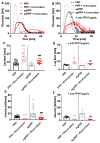Rivaroxaban Effects Illustrate the Underestimated Importance of Activated Platelets in Thrombin Generation Assessed by Calibrated Automated Thrombography
- PMID: 31731710
- PMCID: PMC6912513
- DOI: 10.3390/jcm8111990
Rivaroxaban Effects Illustrate the Underestimated Importance of Activated Platelets in Thrombin Generation Assessed by Calibrated Automated Thrombography
Abstract
Background: The direct oral anticoagulant rivaroxaban inhibiting specifically activated factor X (FXa) causes delayed thrombin generation (TG) as measured by calibrated automated thrombography (CAT). The implications of these changes for assessing bleeding or residual prothrombotic risks of patients are unclear in the absence of a better understanding of the underlying mechanism.
Methods: We compared platelet rich plasma (PRP) without or with prior collagen-induced platelet aggregation (agPRP) in the CAT assay to better characterize TG in the presence of rivaroxaban.
Results: In the presence of rivaroxaban, TG curves in agPRP showed a distinct profile with a rapidly ascending phase followed with a protracted phase. Inhibition of tissue factor pathway inhibitor amplified the first phase of the curve which was also modulated by procoagulant phospholipids. Inhibition of FXIIa-dependent FXI activation revealed that aggregated platelets influenced the first phase by a combination of extrinsic and intrinsic coagulation pathway initiations. Thrombin-dependent amplification of TG (even prior collagen activation) was responsible for the second phase of the TG curve.
Conclusions: AgPRP fully includes platelet ability to support TG and reveal distinct TG phases in the presence of direct FXa inhibitors highlighting its potential use in an anticoagulated setting.
Keywords: factor Xa inhibitor; phospholipids; platelets; thrombin.
Conflict of interest statement
The authors state that they have no conflict of interest.
Figures





References
-
- Castoldi E., Duckers C., Radu C., Spiezia L., Rossetto V., Tagariello G., Rosing J., Simioni P. Homozygous F5 deep-intronic splicing mutation resulting in severe factor V deficiency and undetectable thrombin generation in platelet-rich plasma. J. Thromb. Haemost. 2011;9:959–968. doi: 10.1111/j.1538-7836.2011.04237.x. - DOI - PubMed
LinkOut - more resources
Full Text Sources
Research Materials
Miscellaneous

